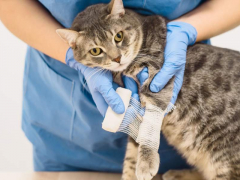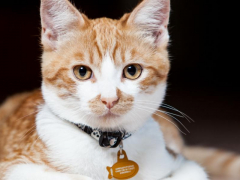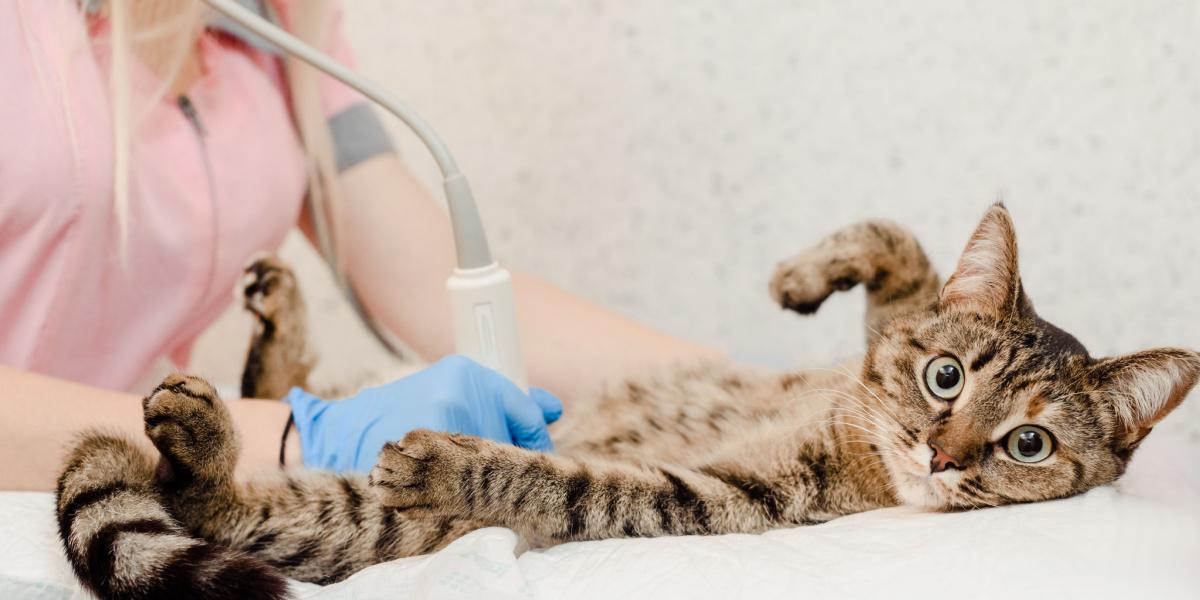
Ultrasound is an important diagnostic tool, even for cats.
Ultrasound has become a common diagnostic procedure carried out on both healthy and sick cats and is now seen as a key part of good veterinary care. This article explains what an ultrasound is and the purpose of using ultrasound for cats.
What Are Ultrasound Examination in Cats?
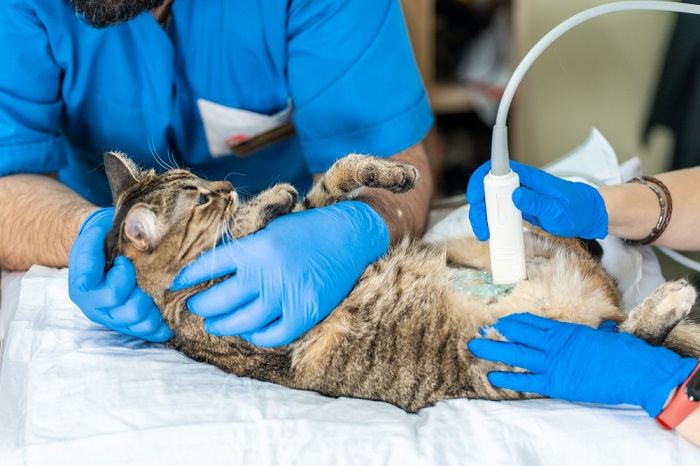
Ultrasounds for cats provide insight into what is going on with your cat internally.
“Ultrasound” is a commonly used expression to describe a diagnostic tool also known as a sonogram.
Ultrasound uses high-frequency sound waves (ultrasonic waves) to create an ultrasound image of part of the inside of the body.
The word “ultrasound” comes from the Latin word “ultra,” which means “beyond.” Ultrasound machines use sound waves that are too high a frequency for humans to hear. This is why they are “beyond sound.”
This sound for ultrasonography is generated by a small handheld probe with a smooth, dome-like tip that is pressed against the cat’s skin during the procedure. Fur is removed from where the probe is placed.
The ultrasonic sound waves bounce off different parts of the inside of the cat’s body, creating echoes that bounce back to the probe, which detects them and translates them into electronic data. The ultrasound machine then uses computerized calculations to turn the data from the bounced-back sound waves into a moving image.
This image is displayed on the monitor of the ultrasound machine while the scan is carried out. A recording of the scan is stored and still images are analyzed. Measurements are taken from these images, allowing a detailed analysis of your cat’s many internal structures.
Why Not Use X-Rays For Your Cats?
An ultrasound exam is different from radiology (x-rays) because it provides a moving image in real-time. It is able to discern more of the internal structure of the cat’s body, rather than just a static silhouette-type outline, as seen in radiographs (x-rays).
Ultrasound is also different from CT and MRI scans because of its accessibility. It is available in many veterinary hospitals and clinics and is much less expensive. However, ultrasound does not provide as much detail.
A special type of ultrasound uses doppler technology to assess blood flow in specific blood vessels, and to monitor specific flow around heart murmurs and narrowed blood vessels. An ultrasound examination of the heart is known as an echocardiogram.
Also Read: How Much Does A Cat X-Ray Cost?
Why Cats May Need An Ultrasound
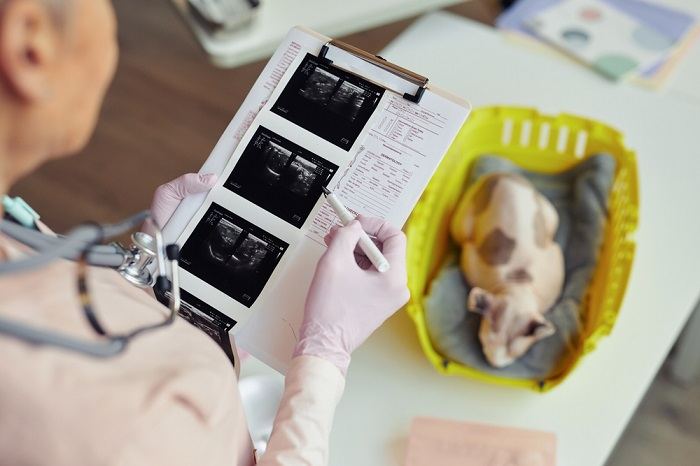
Ultrasounds images provide a window into your cat’s internal health.
An ultrasound procedure is used to visualize the internal anatomy of a cat.
Ultrasounds have several purposes:
- To monitor normal physiological conditions (such as pregnancies)
- To find out more about internal organs and to diagnose abnormalities
- To guide a surgeon during certain procedures, such as collecting a biopsy from a suspected tumor or lymph nodes.
What does an abdominal ultrasound of a cat show?
One example of why ultrasound examinations may be carried out on sick cats would be suspected abnormalities of different abdominal organs, including the pancreas, gastrointestinal structures, urinary bladder, and other soft tissue structures. Ultrasounds are used to Investigate symptoms of various diseases and conditions, such as weight loss, or to look for the possibility of a foreign object inside your cat that may have been ingested.
Also Read: Heart Disease In Cats: Causes, Symptoms, & Treatment
How It Works
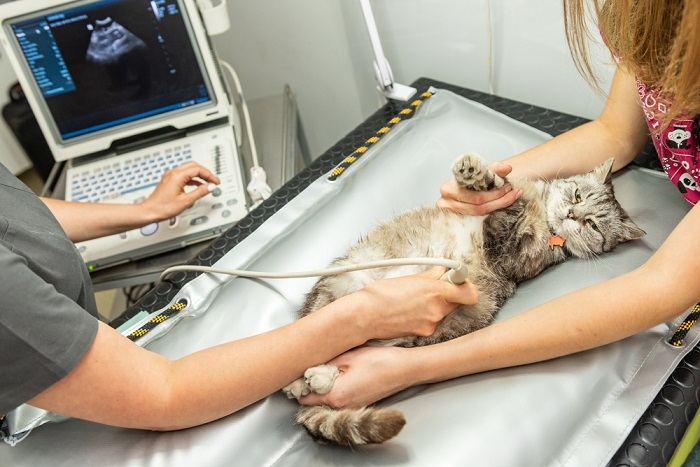
Gently restraining your cat during an ultrasound will provide the best results.
If your cat needs to have an ultrasound, here are some things that you can expect:
- An appointment for the scan with your DVM veterinarian. An ultrasound scan may take half an hour or more. For this reason, ultrasound scans often only happen at specific times. In these cases, procedures need to be booked in advance. Occasionally, a scan is carried out as part of a normal consultation. This, however, is rare.
- Your cat does not normally need to fast prior to a scan. Check with your veterinarian beforehand to be sure.
- You may be able to stay with your cat during the procedure. Check with your veterinarian.
- Your cat may need to be sedated or given a general anesthetic before the procedure, depending on your cat’s individual circumstances.
- Your cat will be gently restrained while fur is removed from the area where the scan is placed.
- Clear gel is used to optimize the contact between the ultrasound probe and your cat’s skin and is placed on the probe or on the cat’s skin.
- The scan may be visible on the screen of the ultrasound machine while this is being done. The operator may or may not make comments about what they see.
- The scan may be brief (less than five minutes) or lengthy (up to 30 minutes). This depends on the type of scan and the complexity of the findings.
- After the scan, the operator may explain their findings to you immediately, or you may need to wait.
Also Read: Intestinal Cancer In Cats: Causes, Symptoms & Treatment
How Much Does It Cost To Do A Cat Ultrasound?
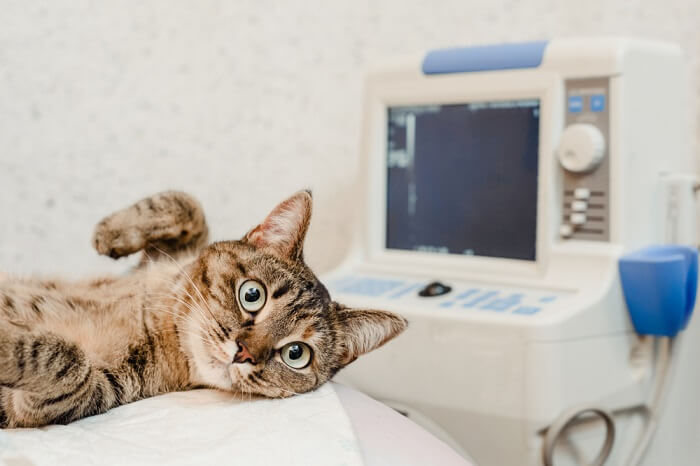
The costs of ultrasounds for your cat vary depending on the nature of the issue and other factors.
The cost of an ultrasound examination for cats varies widely, depending on a number of factors:
- The type of problem under investigation. For example, checking for pregnancy is simple and quick to do, while a full abdominal ultrasound is far more complex.
- The training, qualifications, and experience of the ultrasound operator
- The type of ultrasound machine used
- Your location
An ultrasound scan could cost as little as $50 or as much as $500. You should ask your veterinarian for an estimate in advance.
It’s important to understand that an ultrasound scan is not a set procedure. A quick scan carried out by a vet who rarely uses ultrasound on cats is different from a detailed scan carried out by an expert using the latest technology. To a large extent, you get what you pay for.
Also Read: Do Cats Know When You’re Sick?
To sum up, an ultrasound examination is a type of advanced diagnostic imaging procedure that uses echoes from high-pitched, inaudible, sound waves to create computer-generated moving images that represent the internal anatomy of the body. Ultrasound is a highly useful method of finding out more about the internal goings-on in a cat’s body. Check with your veterinarian about the particulars of the procedure, the cost, and how to schedule the procedure.
Also Read: Lethargy in Cats: Causes, Signs, Symptoms & Treatment
